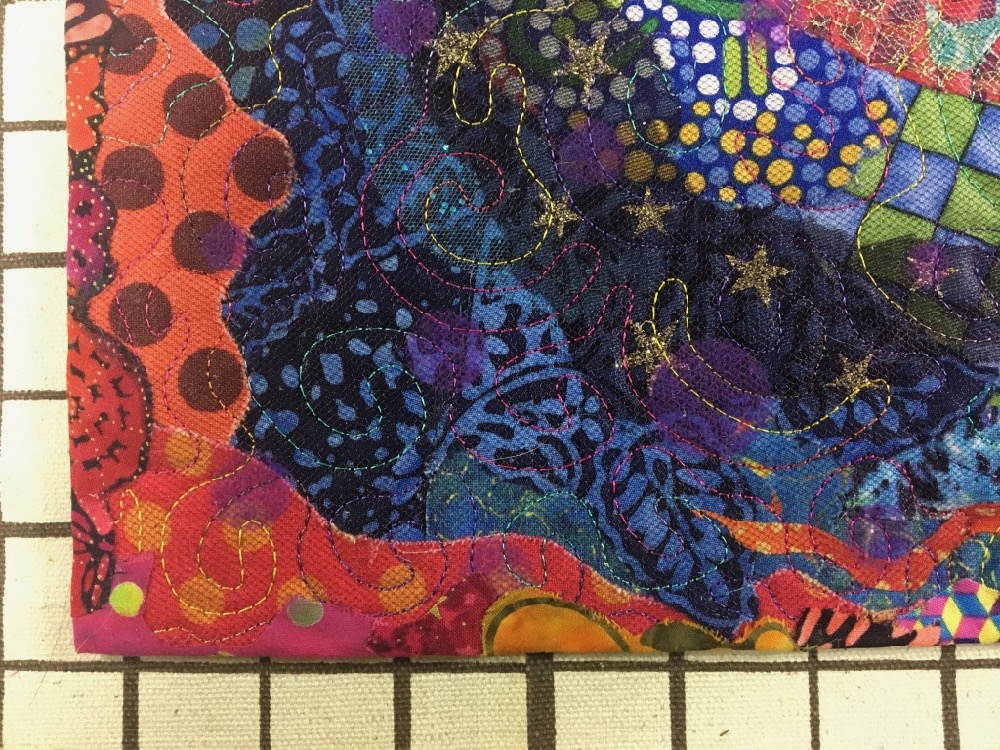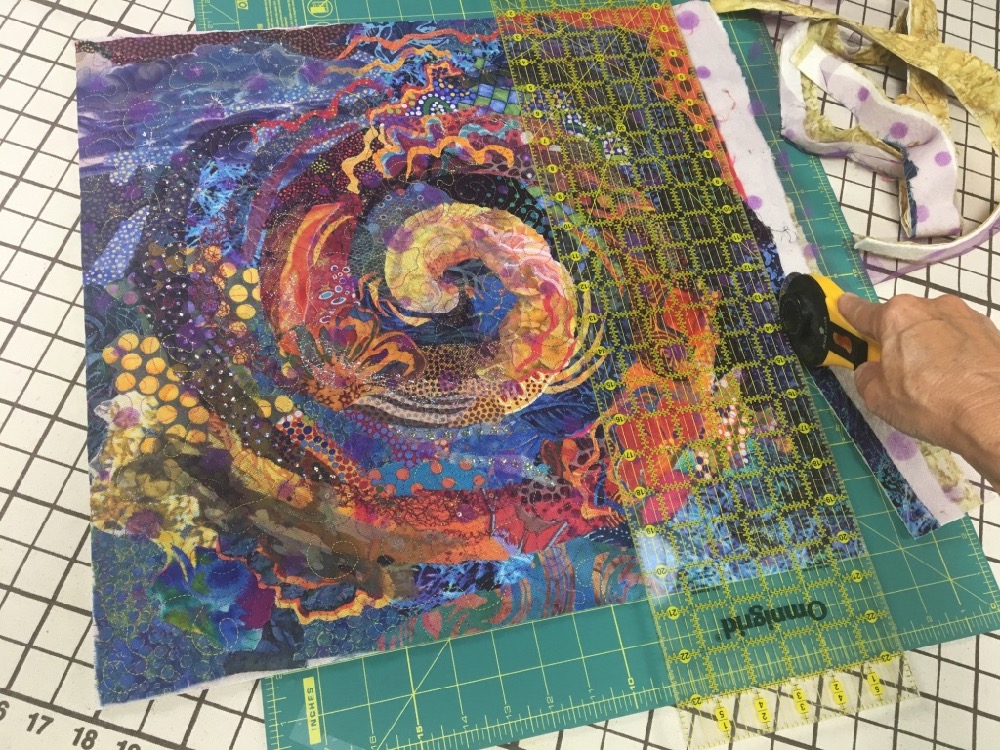Finishing: Put the Final Touch on Your Fabric Collage Quilt—Fabric Collage By the Numbers #15
You’re nearing the finish line. You’ve quilted your piece and now are considering methods for finishing the edges. There are several ways you can create a binding. If you have much experience in quilting, you probably have a favorite go-to binding method.
In this post I’ll stick to the ways I’m most familiar with. The wrap and glue binding is my favorite as it continues the collaging right up to and over the edge. But some other methods may be useful to you too, depending on the situation, so study each option carefully before committing and, most importantly, before taking the rotary cutter to your edges!
Tom and I are using part of our summertime to provide you with a sort of DIY Summer Collage Camp—or a Winter Collage Camp for those of you in the Southern Hemisphere. We’re calling it “Fabric Collage By the Numbers,” addressing all the steps of creating a fabric collage quilt. We hope you’ll participate from wherever you are in the world—no travel involved.
Pulling from six and a half years of fabric collage blog posts as reference material, we are delving into that content to give you a summertime lineup that you can follow along with. At the start of this series, there were eight weeks left of summer (not by the calendar but by the very subjective lens of the Maine climate!) so each week we’ll deliver two posts for a total of sixteen in the series—unless we re-discover more relevant posts along the way!
Posts from our Summer Special include; #1—choosing your photo (posted on July 7), #2—choosing a subject (posted on July 9), #3—making a pattern (posted on July 14), #4—how to choose fabric (posted on July 16), #5—making a fabric palette (posted on July 21), #6—using glue in fabric collage (posted on July 23), #7—sequence in fabric collage (posted on July 28), #8—sequence in faces (posted July 30), #9—adding sheers in sequence (posted August 4), #10—using your background to tell the story (posted August 6), #11—basics of adding sheer fabrics to your collage (posted August 11), #12—deciding when your fabric collage is finished (posted August 13), #13—using tulle for shadow quilting (posted August 18), #14—free-motion quilting (posted August 20) to eventually hanging your fabric collage on the wall (planned delivery on August 27), we’ll cover each step with at least one previous post.
You may have read some of these posts before, if so this will be a refresher for you. The information may also be reminiscent of information found in our online learning resource the Fabric Collage Master Class. If so, know that you’re not imagining things. Much of this information is gathered, reorganized and expanded upon in the Master Class. For more information about the Fabric Collage Master Class, click the button below.
Finishing: Put the Final Touch on Your Fabric Collage Quilt
Let’s say you’ve nearly finished your fabric collage quilt. For me, it’s my crazy spiral you’ve seen in recent posts. Pieced image: done. Details: done. To tulle or not to tulle: done. Quilting: done.
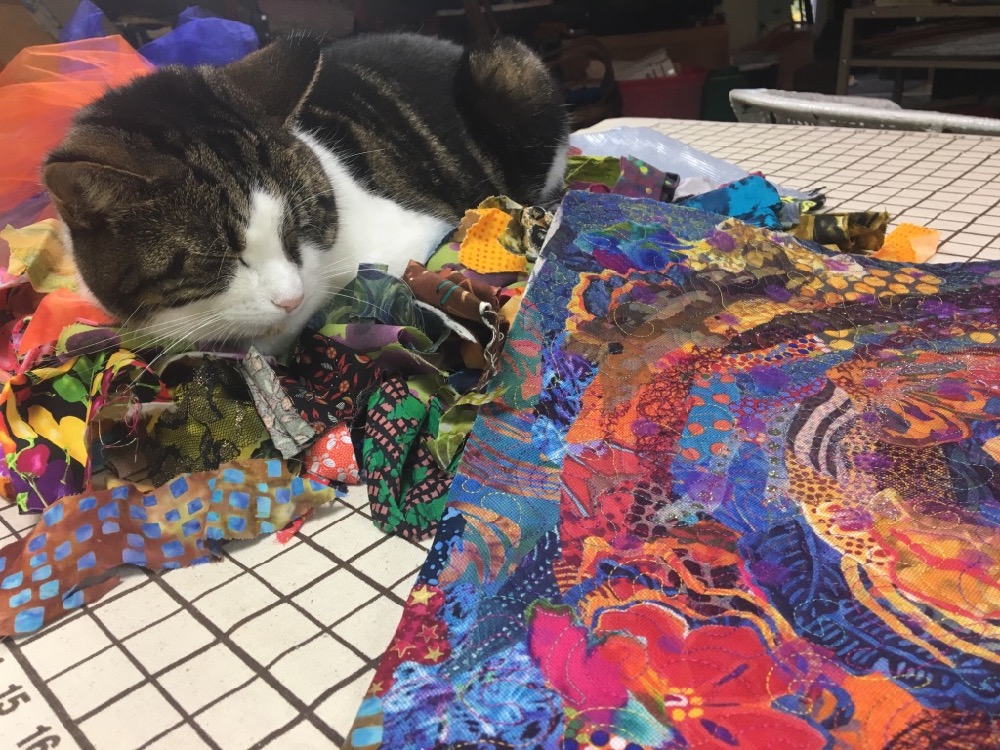
Now what? How do you finish your fabric collage quilt?
Here’s the basic steps of what I’m going to do:
- Press quilt flat
- Trim quilt to size
- Decide how to finish the raw edge
There are many ways to finish the edge of a quilt, several of which I have used. There’s the traditional sew and turn binding, which frames your quilt. There’s a knife edge, or faced, binding which I’ve only used on more recent quilts such as Crocodylus Smylus and Kaloli Moondance. Between my two my books, Free-Style Quilts and Serendipity Quilts, I present four other ways to edge a quilt—all of which are also included in the binding section of my Online Fabric Collage Master Class.
For my little crazy spiral quilt, I’m going to demonstrate a favorite technique for edges, one from Serendipity Quilts: my wrap and glue binding. It’s fun and loose and goes right along with the whole cut and glue theme. It might even be something you haven’t tried before.
Preparing Your Quilt
Where some people may block a quilt flat, I press it flat, using a cool iron or an iron with a pressing cloth. I see it as “relaxing” the fibers.
IMPORTANT: if you have used any lovely sheer or semi-translucent fabrics in your quilt or used a layer of tulle over-all, NO hot iron. Yes, it will melt polyester fabrics, which is what most of those great sheers are made of. Take my word for it.
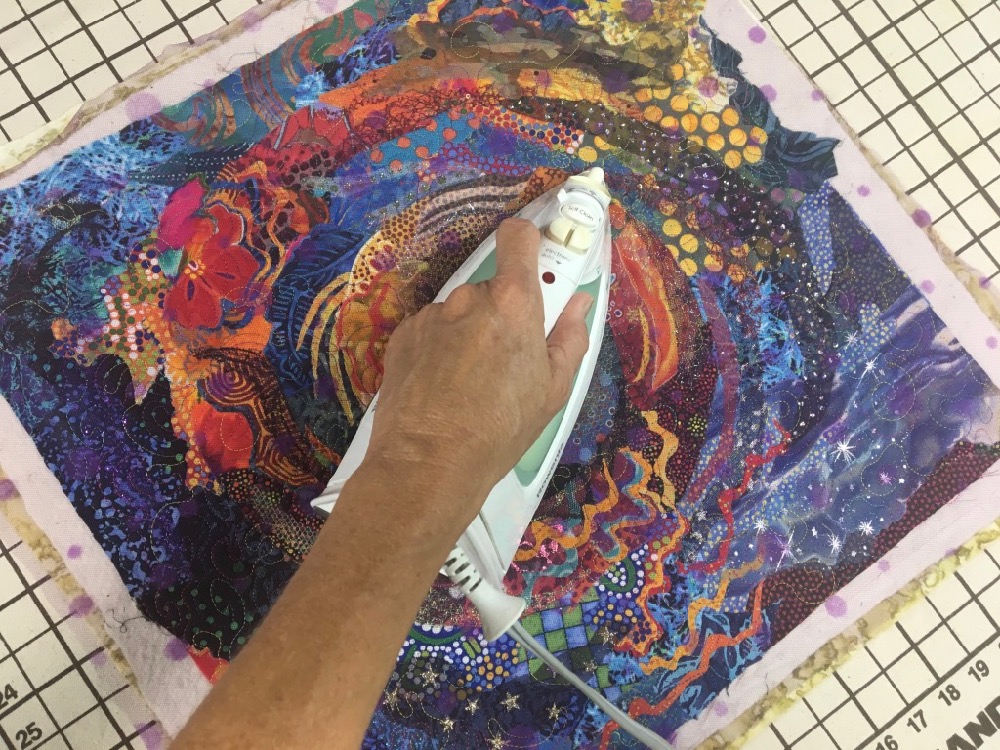
ALSO IMPORTANT: Do not block a fabric collage quilt. The quilt is held together with water-soluble glue, blocking a quilt means dampening it, the glue will disperse, edges WILL lift, and small pieces or details could potentially fall off. Same goes with throwing these babies into the washing machine. No! Don’t do it. These collage quilts are art for the walls, not (functional) art for a bed. The same goes for a good dose of steam pressing. I had a great steam iron once, steamed the heck out of a piece that had all edges glued down, and then wondered why so many edges were loose again as I started quilting. Duh.
So, use a little warmth and massage with an iron to relax the quilt, and it should now be looking nice and flat.
Next, it needs to be squared off. I use a rotary cutter and cutting mat(s). Depending on the size, I place it either on the floor or on a table. I employ as many tools as I need to get a good result. I use straight edges, transparent plastic quilter’s rules, metal rulers, even a metal carpenter’s square. If it is an exceptionally large quilt I may have to use all of these at once—adding a carpenter’s chalk line when squaring up my 22 foot long quilt of Stevie the crocodile. Do whatever you have to do.
To ensure that the trimmed edges are perpendicular and parallel to one another, I start with a large, square quilter’s rule (below left). Once the first corner is cut correctly, I can then measure off those two edges to trim the others (below right).
I check for square by measuring from each side and diagonally from corner to corner. I take my time doing it. Checking and double-checking myself. I may be pretty loose in constructing my quilts, but if a quilt is meant to be square, I’m going to be precise.
Measure twice—or three times—or more—cut once.
Wrap and Glue Binding
The first time I tried a wrap and glue binding it was on the portrait of my then 3-year old son, Sam. I took the quilted—but not yet trimmed to size—image to a fiber arts group I was part of. I described how I planned to trim it square and edge with a fine red (Sam’s favorite color at the time) binding. They gasped and said, “No! He has too much energy to be confined like that! Leave it like it is and just hang it up!” Now, there was batting still sticking out the edges and it was a highly irregular shape overall. I cut it square (see above note about being precise).
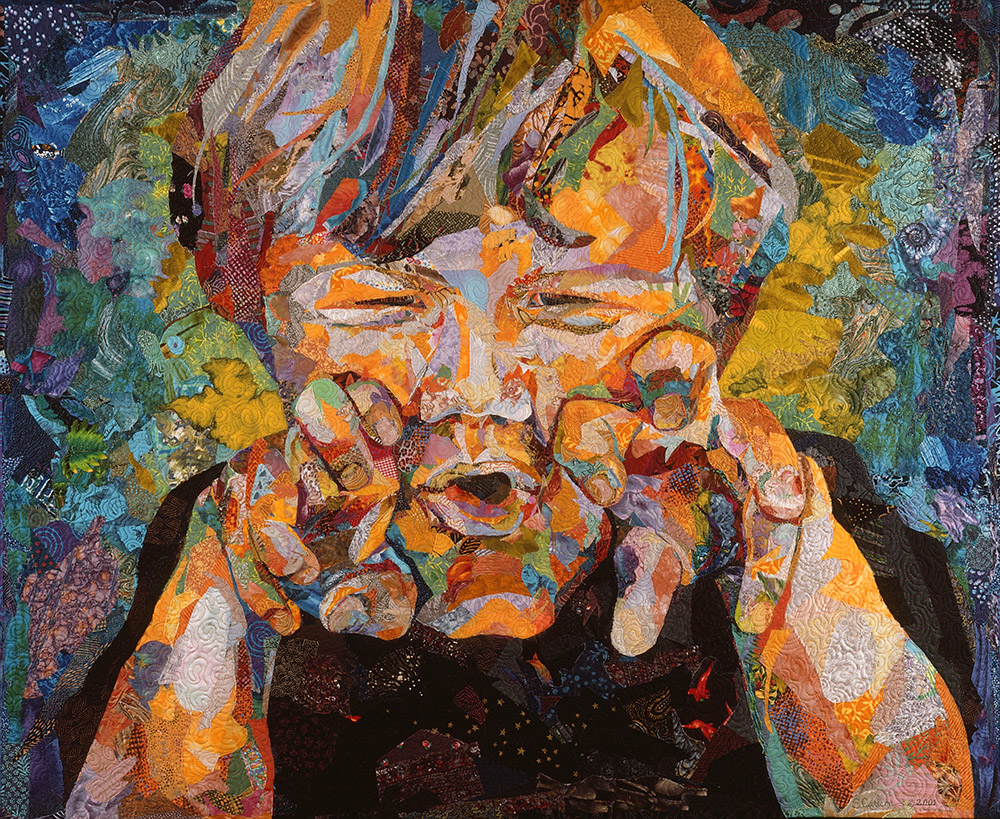
However, I did think about what my friends said about not confining his dino-energy and thought about how I could continue his image around the edge. I selected bits of leftover scrap fabric that I already used in the portrait, blending them into and gluing them onto the top of the quilt. With each little piece, I added more glue as I wrapped it around the edge and secured it—yes, with glue—to the back.
The effect was to continue the image right up to and around the edge, for a “borderless” appearance.
Since that quilt, I’ve used the wrap and glue technique on other quilts. In my big ol’ butterfly quilt Exuberance, for example, the small one- to two-inch squares I had scattered like confetti in the background seemed like they’d be a good choice for a glued edge as well. So I started doing that, but after a couple feet of gluing those small squares, the amount of time it took had me thinking twice about it.
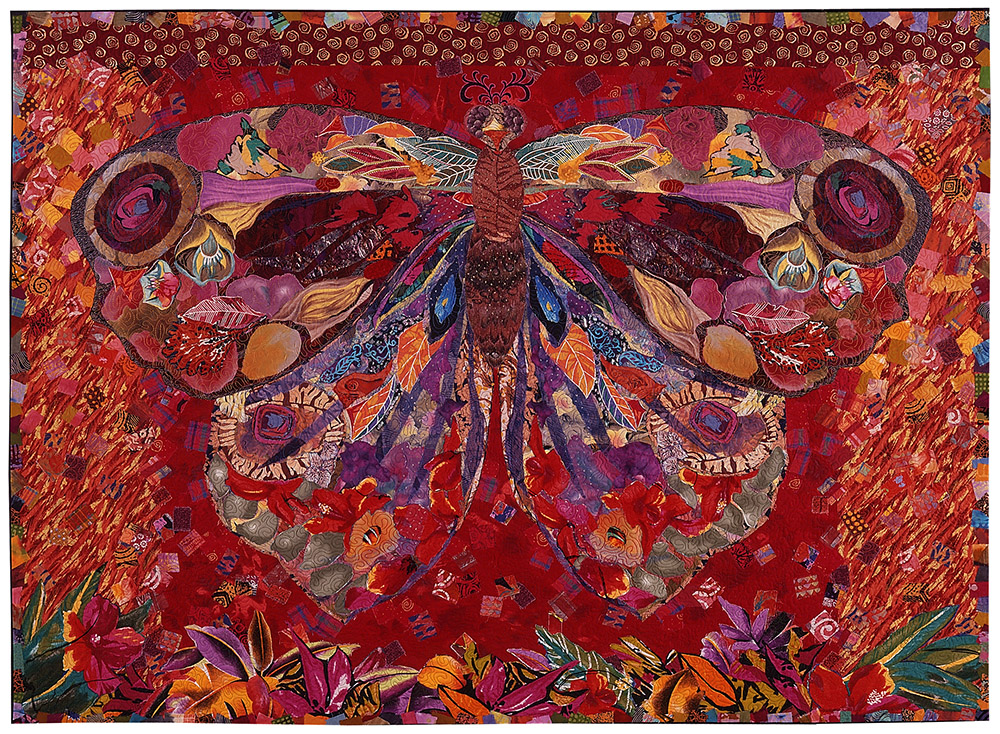
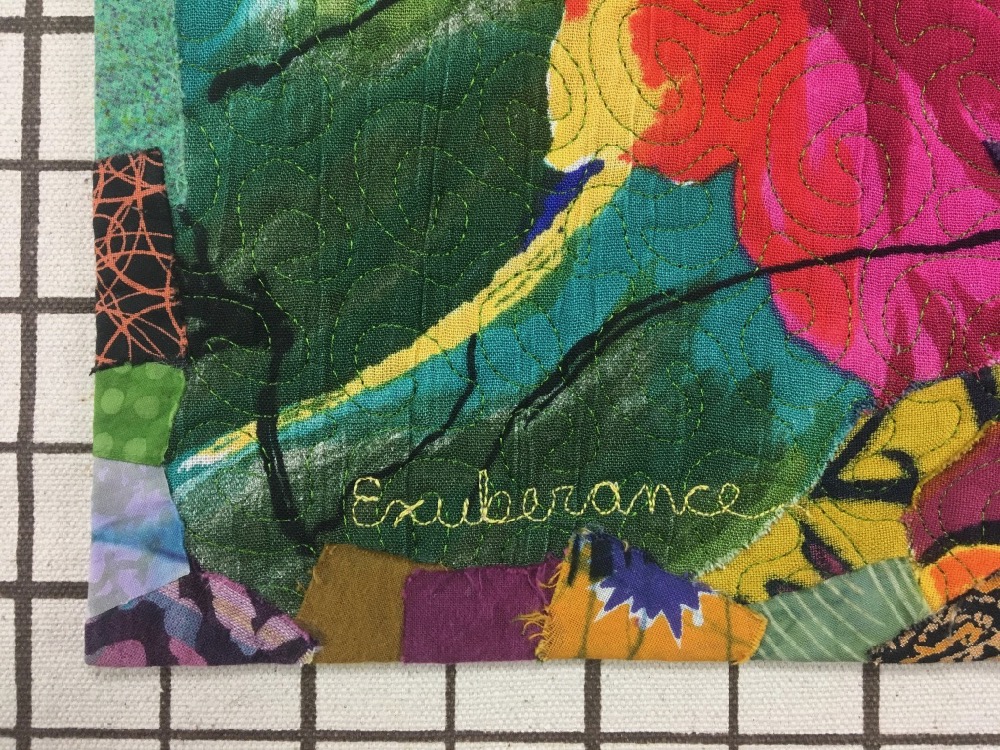
When I bring this finishing technique up in classes, my students light up, hearing that they can just keep gluing all the way to the end. But I do point out that this is not necessarily a quicker way of finishing an edge. It will depend on the size of your quilt and the size of the pieces of fabric you’re wrapping with.
On Exuberance, there was lots of surface area on all those individual squares, with a slow progression of linear feet covered. But when I saw how it was coming together, I decided I liked it, and bit the bullet. So it took a day or so to cover that perimeter. It was done, and it was appropriate.
But I’m particularly happy with how the binding of my mandala quilt, Toad and Dragonfly worked out.
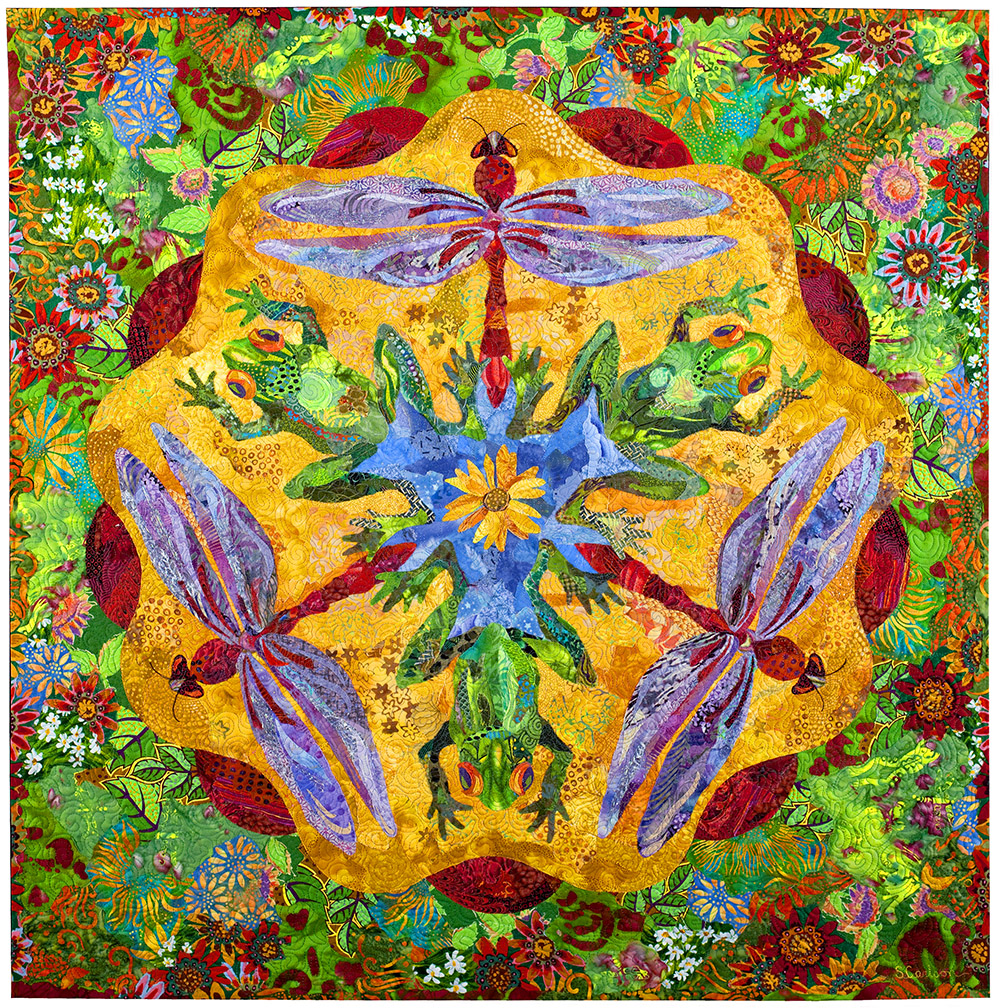
The garden flowers of the background were cut from many different fabrics and collaged in place. The greener parts of those fabrics were placed next to the mandala itself for contrast, with more and more of the multi-colored flowers worked toward the edges—creating a vignette.

Once it was quilted and trimmed, I thought about how to finish the cut edges. Continuing cutting out flowers to wrap around the edges of the quilt seemed like a natural. It was just what I wanted for my garden pond mandala.
So if this finishing technique interests you, here’s a video showing how it’s done.
Maybe a wrapped and glued binding will further the idea or story of your quilt, or maybe it’s just something you want to try. Either way, gather scraps and bits of fabric that blend or maybe contrast with the quilt. Lay them along the cut edge to see what looks good. Grab the glue bottle, smear some glue onto the back of a fabric piece, press it onto the top of the quilt, wrap it around the edge, secure to the back. Repeat until done.
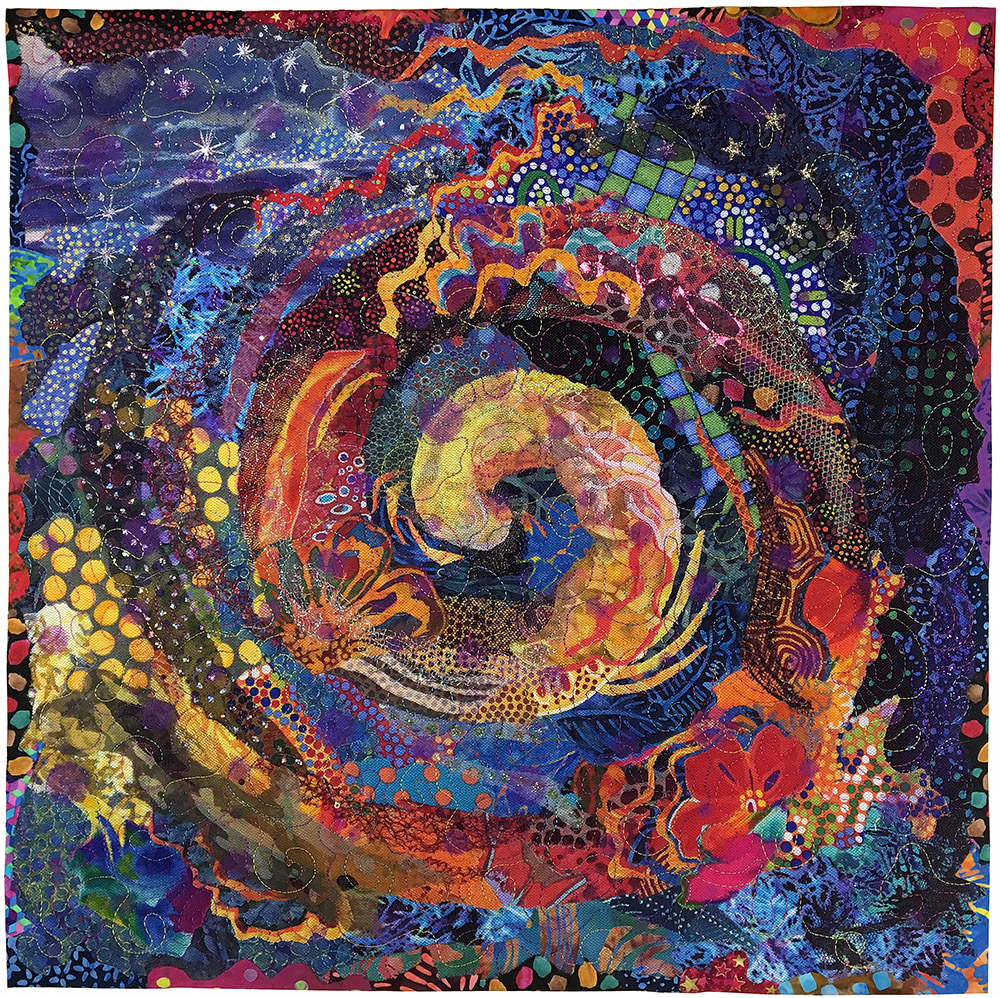
FAQ’s
Q: Do you neaten up the edges of all the individual fabric pieces on the back of the quilt?
A: No. I may trim off stray ends but I usually glue them down as they are. I like the unexpected randomness for anyone who cares to look at the back.
Q: Can you use this binding if you have tulle as a top layer as with shadow quilting? Will the glue adhere through the layer of tulle?
A: Yes, but you definitely want to get a nice smeared coating of glue onto the bit of fabric that’s going to wrap around—though not so much that it squishes out when you apply pressure to adhere it to the quilt top. The glue will sink through the tulle and attach quite nicely to the fabric beneath.
Q: Do you then add more quilting to the top of the quilt, over the now glued edge?
A: No, it remains a purely glued edge, attached on top of the quilt. When I first tried this technique with Samuelsaurus Rex in 2001, I was wondering about how this sort of binding would last through the years. As it happened, I was finishing a series of three beetle quilts at that same time, wrapping and gluing those edges as well. So for a test, I ran a topstitch around the beetles, leaving Sam’s as a glued edge only. Time—now 16 years of it—has proven that either way is fine—though personally, I like the look without the topstitching better.
The beetles left to right: Fire Beetle, Life in the Leaves, Rolling Up the World; 2001, each 33 x 49 inches.
